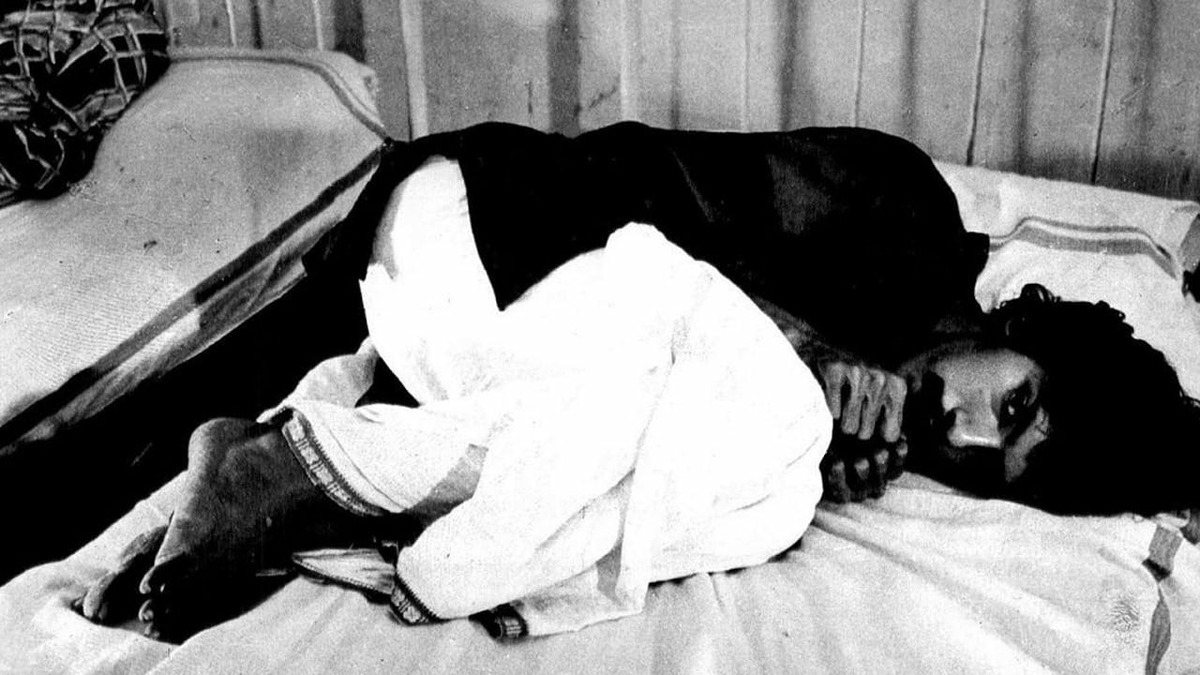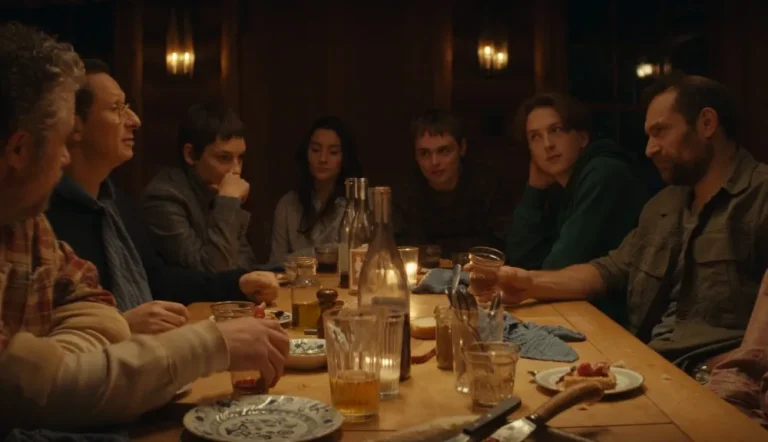Watching G. Aravindan’s “Pokkuveyil,” released in 1982, is like reading a Sylvia Plath poem, full of restrained sorrow, inner turbulence, and the kind of sadness that doesn’t leave but lingers. It’s very precise, poetic, and quietly devastating. It wouldn’t be a lie to say that the despair is haunting.
On the Deeply Personal Nature of Balu’s Distress
The movie revolves around Balu, a college-going student who is both a poet and an artist, seemingly disinterested, yet deeply caring in his relationships, whether with friends, parents, or his lover. He is portrayed beautifully and with striking realism by Balachandran Chullikkad, who is also a well-known poet in Kerala in real life.
The opening scene takes us to the stark, realistic setting of a mental hospital, where we see Balu’s mother and uncle visibly worried about him. He appears withdrawn, frightened, and sad. There is an unsettling overlap of patient murmurs and the dreadful silence of the asylum, both coexisting to create a soundscape that feels quietly suffocating. When the doctor inquires about the cause, the mother attributes it to the death of his father, saying it has shaken them all.
But is that all?
To understand, we are slowly drawn back into Balu’s world. He is often shown at home, sketching, quietly sitting by himself, saying very little. Always alone, always with himself. We are then introduced to four characters with whom he shares a close bond: his friend Joseph, his father, another unnamed friend who plays basketball, and his lover. Let us also not forget the loving mother, whose quiet affection and attentiveness allow her to sense, early on, that something isn’t right with her son.
At first, Balu is stunned to see his father’s death, the very first void that’s been created. Next is his dear friend Joseph, who understands him deeply but leaves with a promise to come back and include him in the revolution he plans. In the end, none of it works out, leaving Balu utterly alone. Then comes the plight of his friend, a basketball player, who dreams of playing for the nationals, only to have those dreams shattered.
So, when the mishap occurs, it feels like Balu doesn’t know his friend anymore; the relationship quietly unravels, lost to the weight of a broken dream. And the final departure is his lover, who is from a rich household, now wants to move to Bangalore with her father. She gifts him a tape of songs. It is in this moment that our hero shows the slightest of emotions; he pleads with her not to leave him alone. Disgusted, she pulls herself away.
While Balu experiences each departure in silence, it’s this accumulation of loss that is layered and continual, that slowly disorients him. It’s very saddening to notice that even when surrounded by people, he remains largely an observer. When Balu is seen to have conflicts within his mind, the pain feels personal, almost feeling like extending a warm hug to him, to say, You are not alone! He doesn’t share dreams or fight for causes, unlike those around him.
Detached, internal, and painfully sensitive, he absorbs the fading of each bond like twilight swallows light. As the name of the movie suggests, Balu’s life is also seen to be in a phase of transition, or rather, always in a state of perpetual darkness.
Aren’t we all a little lonely and lost in life? Just like the protagonist. That quiet, persistent ache lingers within us, making his journey feel so familiar and deeply human. People come and go; change remains the only constant. But aren’t we all secretly suffering the loneliness that follows? Through Balu’s story, we see a reflection of our own vulnerabilities and hopes, reminding us that, despite the silence, we are not alone in what we feel.
The Film’s Soul: Music And Cinematography
Aravindan is a mastermind; he is a legend among the many important directors Malayalam cinema has had. Among the many visionary voices in Malayalam cinema, Aravindan holds a unique place for his deeply contemplative approach to storytelling. Films like “Chidambaram,” “Kummatty,” and “Uttarayanam” are some of the finest examples that reflect this distinct narrative style.

The music that is composed by Pandit Hariprasad Chaurasia (flute) and Pandit Rajeev Taranath (sarod) does not merely accompany the visuals but drives the narrative forward. The slow alap at the beginning mirrors the protagonist’s numb, disconnected state, while the tempo picks up in tandem with his rising inner turmoil.
The flute, in particular, becomes a metaphor for his emotional condition, its tonal shifts echoing his psychological descent. The flute notations are, by themselves, a chapter to write about while we analyze the movie. Devdas and Hameer’s sound design, especially their interplay of sound and silence, deepens this impact on a greater level. Silence in “Pokkuveyil” is not emptiness; it’s tension, isolation, and detachment; moreover, it’s haunting.
Coming to cinematography, Shaji N. Karun is one of the most critically acclaimed cinematographers we have. His work includes milestones in Malayalam cinema such as “Kummatty,” “Chidambaram,” “Esthappan,” and many others. In “Pokkuveyil,” too, he creates sheer magic with his framing. Every shot feels like a textbook example, something you would want to go back to and learn from, as is the case with all his films.
Much of the film is set in twilight, with lingering close-ups, starting from the characters in the asylum to that final haunting shot of the mother watching her son return, along with Balu, curled into a fetal position. These are frames that hold meaning, pushing the viewer to reflect on what each character is truly going through.
Interpreting the Visual Imagery and Symbolic Layers Embedded in the Film
As mentioned earlier, this film is truly a masterpiece, one that invites repeated viewing to discover its many layers. That said, here are a few interpretations that emerged after watching it closely. Let us start with the first one, water. The waves and reflections are shown at all critical points of the movie. The fast-moving ripples showcasing the inner conflicts and aching of our character are brilliant. Coupled with the film’s reliance on twilight, it creates visuals that are suffused with muted colours and silhouettes. This reflects the overall gloom and external stagnation.
Next is a very notable yet subtle portrayal of class distinction, which is a personal interpretation. Throughout the film, we notice visual and linguistic contrasts between the rich and the impoverished. The affluent characters are often dressed in shirts and pants, while the protagonist and those around him wear the more modest mundu (dhoti) and shirt.
There’s also the use of language as a marker of class: the rich frequently speak in English, while the others communicate in Malayalam. Even the protagonist’s lover, played by the late and celebrated actress Kalpana, is shown to come from a wealthy household, as she casually mentions the foreign brand names her father has bought for her. Eventually, she leaves him for a better lifestyle. These minute choices hint at a deeper commentary on social hierarchy that quietly threads through the film.
Every imagery and symbolism is often paired with minimalist flute compositions by Shri.Hariprasad Chaurasia. The music doesn’t direct emotion but rather lingers in the background, allowing the image to breathe. Together, the visuals and sound create a meditative stillness, echoing Balu’s mental state, detached, slowly dissolving, yet deeply present. The absence of dramatic musical cues lets silence and ambient sounds, like distant waves or a passing breeze, do the emotional heavy lifting. In this way, the film doesn’t tell you what to feel; it simply holds space for you to feel it.
Lastly, the dreams Balu has towards the end of the movie further reflect his deteriorating mental state. The usually silent Balu is seen calling out to his mother, mumbling at night, and sleepwalking through the corridor, unable to collect himself and gradually losing himself. It is the most painful part of the movie where the protagonist is trying hard to cope with the departure of everyone he once loved.
The brilliance of ‘Pokkuveyil’ has not only given it a great reception from the viewers but also been celebrated through several prestigious awards. The film earned G. Aravindan the Kerala State Film Award for Best Director in 1981 and was later honoured with the National Film Award for Second Best Feature Film in 1982, shared by Aravindan and producer K. Ravindranathan Nair. In addition, the subtle yet powerful soundscape of the movie earned Deva Das the Kerala State Film Award for Best Sound Recordist.
Setting aside the awards and recognition, the film had a profound personal impact. With every rewatch, the sense of empathy toward Balu only deepens; it evokes a kind of quiet pain, a heavy loneliness that stays. “Pokkuveyil” isn’t just a film; it’s an experience that makes you reflect on people, on emotions, and on the fragility of the human mind. Everyone should explore more of G. Aravindan’s work, not just for the brilliance in craft, but for the subtle, layered truths he captured about life itself.



![Blind [2020] Review – A dull, inspid home invasion horror that’s hard to sit through](https://79468c92.delivery.rocketcdn.me/wp-content/uploads/2020/12/Blind-highonfilms-3-768x465.jpg)

![Black Easter [2021] Review – Christploitation time travel film is an absolute cringe-fest](https://79468c92.delivery.rocketcdn.me/wp-content/uploads/2021/06/Black-Easter-1-highonfilms-768x321.jpg)
